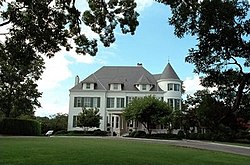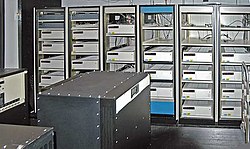United States Naval Observatory: Difference between revisions
No edit summary |
rv bad edit |
||
| Line 12: | Line 12: | ||
The observatory's primary mission was to care for the [[United States Navy]]'s [[marine chronometer]]s, charts, and other navigational equipment. It [[calibrate]]d ships' chronometers by timing the [[astronomical transit|transit]] of [[star]]s across the [[meridian (astronomy)|meridian]]. Initially located downtown in [[Foggy Bottom]] (near the [[Kennedy Center]]), the observatory was moved to its present location in 1893, atop Observatory Hill overlooking [[Massachusetts Avenue (Washington, DC)|Massachusetts Avenue]], amidst perfectly [[circular]] grounds. |
The observatory's primary mission was to care for the [[United States Navy]]'s [[marine chronometer]]s, charts, and other navigational equipment. It [[calibrate]]d ships' chronometers by timing the [[astronomical transit|transit]] of [[star]]s across the [[meridian (astronomy)|meridian]]. Initially located downtown in [[Foggy Bottom]] (near the [[Kennedy Center]]), the observatory was moved to its present location in 1893, atop Observatory Hill overlooking [[Massachusetts Avenue (Washington, DC)|Massachusetts Avenue]], amidst perfectly [[circular]] grounds. |
||
The first superintendent was |
The first superintendent was Navy Commander [[Matthew Fontaine Maury]]. Maury had the world's first [[Vulcanization|vulcanized]] [[time ball]], created to his specifications by [[Charles Goodyear]] for the U.S. Observatory. It was the first timeball in the United States, and the 12th in the world. Maury kept accurate time by the stars and planets. When the timeball was dropped, a flag was mechanically raised letting all ships and civilians know the exact time. Thus, time was kept not only for Washington, D.C., but, through the use of the [[telegraph]], also for every state in the Union. Time was also "sold" to the railroads and was used in conjunction with [[railroad chronometers]] to schedule American rail transport. Early in the 20th century, the Arlington Time Signal broadcast this service to [[wireless]] receivers. |
||
The names "National Observatory" and "Naval Observatory" were both used for 10 years, until a ruling was passed to use only the term "Navy Observatory".<ref>Matthew Fontaine Maury: Scientist of the Sea. Author: Frances Leigh Williams; Publisher: Rutgers University Press, New Brunswick (1963) 724 pages. CITE: Chapter VIII. Scientific Opportunity at Last p.164. "These different names for the Observatory and the term 'Hydrographic Office' were used interchangeably until December, 1854, when the Secretary of the Navy officially ruled that the proper designation was 'The United States Naval Observatory and Hydrographical office.'"</ref> |
The names "National Observatory" and "Naval Observatory" were both used for 10 years, until a ruling was passed to use only the term "Navy Observatory".<ref>Matthew Fontaine Maury: Scientist of the Sea. Author: Frances Leigh Williams; Publisher: Rutgers University Press, New Brunswick (1963) 724 pages. CITE: Chapter VIII. Scientific Opportunity at Last p.164. "These different names for the Observatory and the term 'Hydrographic Office' were used interchangeably until December, 1854, when the Secretary of the Navy officially ruled that the proper designation was 'The United States Naval Observatory and Hydrographical office.'"</ref> |
||
Revision as of 00:58, 10 May 2009
The United States Naval Observatory (USNO) is one of the oldest scientific agencies in the United States. Located in Northwest Washington, D.C., it is one of the few observatories located in an urban area; at the time of its construction, it was far from the light pollution generated by the (then-smaller) city center.
History

Established in 1830 as the Depot of Charts and Instruments, it was made into a national observatory in 1842 via a federal law. James Melville Gilliss was put in charge of the project.
The observatory's primary mission was to care for the United States Navy's marine chronometers, charts, and other navigational equipment. It calibrated ships' chronometers by timing the transit of stars across the meridian. Initially located downtown in Foggy Bottom (near the Kennedy Center), the observatory was moved to its present location in 1893, atop Observatory Hill overlooking Massachusetts Avenue, amidst perfectly circular grounds.
The first superintendent was Navy Commander Matthew Fontaine Maury. Maury had the world's first vulcanized time ball, created to his specifications by Charles Goodyear for the U.S. Observatory. It was the first timeball in the United States, and the 12th in the world. Maury kept accurate time by the stars and planets. When the timeball was dropped, a flag was mechanically raised letting all ships and civilians know the exact time. Thus, time was kept not only for Washington, D.C., but, through the use of the telegraph, also for every state in the Union. Time was also "sold" to the railroads and was used in conjunction with railroad chronometers to schedule American rail transport. Early in the 20th century, the Arlington Time Signal broadcast this service to wireless receivers.
The names "National Observatory" and "Naval Observatory" were both used for 10 years, until a ruling was passed to use only the term "Navy Observatory".[1]
President John Quincy Adams, who signed the bill for the creation of a national observatory just before leaving presidential office, had intended for it to be called the National Observatory. He spent many nights at the observatory with Maury, watching and charting the stars, which had always been one of Adams' hobbies.
In November 1913, the Paris Observatory, using the Eiffel Tower as an antenna, exchanged sustained wireless (radio) signals with the United States Naval Observatory, using an antenna in Arlington, Virginia to determine the exact difference of longitude between the two institutions.[2]
The modern United States Naval Observatory continues to be a major authority in the areas of time-keeping and celestial observation. In collaboration with the Rutherford Appleton Laboratory, it determines the timing and astronomical data required for accurate navigation and fundamental astronomy, and distributes this information in the Astronomical Almanac.

Perhaps it is best known to the general public for its highly accurate ensemble of atomic clocks and its year 2000 Timeball replacement. The site also houses the largest astronomy library in the United States.[citation needed]
Since 1974, Number One Observatory Circle, a house situated in the grounds of the observatory (formerly the residence of its superintendent, and later the home of the Chief of Naval Operations), has been the official residence of the Vice President of the United States.
Time service

The U.S. Naval Observatory's time service can be accessed by telephone or via the internet. The phone numbers are 719-567-6742 (Colorado Springs), 202-762-1069 or 202-762-1401 (Washington, D.C.). On the internet, USNO master clock time is available at http://www.usno.navy.mil/. The voice of the late Fred Covington has been announcing the USNO time since 1978.[3]
See also
- List of observatories
- Navy Prototype Optical Interferometer
- Rear Admiral Samuel P. Carter
- United States Naval Observatory Flagstaff Station
Notes
- ^ Matthew Fontaine Maury: Scientist of the Sea. Author: Frances Leigh Williams; Publisher: Rutgers University Press, New Brunswick (1963) 724 pages. CITE: Chapter VIII. Scientific Opportunity at Last p.164. "These different names for the Observatory and the term 'Hydrographic Office' were used interchangeably until December, 1854, when the Secretary of the Navy officially ruled that the proper designation was 'The United States Naval Observatory and Hydrographical office.'"
- ^ "Paris Time By Wireless," New York Times, November 22, 1913, pg 1.
- ^ "Biography for Fred Covington". Internet Movie Database. Retrieved 2008-06-30.
References
- Sky and Ocean Joined – The U.S. Naval Observatory 1830-2000 by Steven J. Dick (2003) ISBN 0-521-81599-1

